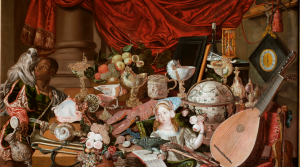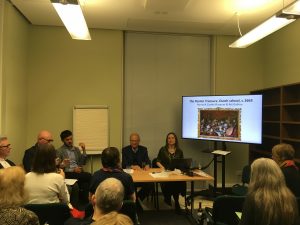THE PASTON TREASURE EXHIBITION: THE WORLD IN A MICROCOSM

Last summer at Norwich, the Castle Museum presented one of its most extraordinary paintings as the result of a five-year research project. The many questions about this painting: who was the artist, when was it painted, what was its purpose, how were the contents chosen and in what ways they reflected the interests of the patrons. These were all issues addressed by the exhibition but not all were answered. On 10 June, there was a seminar at the Institute of Historical Research, which gathered together experts in some of these topics to discuss the story of the painting beyond the exhibition. Lead by two of the curators, Andrew Moore former Keeper of Art, at Norwich Castle and Francesca Vanke, current Chief Curator and Keeper of Fine and Decorative Art, the discussion brought out the enormous potential of the painting and the exhibition to indeed create a particular history in microcosm.
The exhibition took advantage of the wealth of information provided in the painting, to explore different aspects of English social, cultural and artistic life in Britain in the middle years of the 17th century. Starting with the paintings, it related the technical work that had been done to look at how the work had been painted, uncovering evidence to alter previous opinions and to support others. The figure of the young girl, often thought to have been added as an afterthought, was for example, part of the composition from the beginning. On the other hand, where there is now a clock on the far right hand side, originally a silver basin had been included, which complemented the silver ewer on the other side, which was in turn covered with a portrait of a woman. Painted quickly in succession, this would seem to be yet further proof of the close involvement of the patron in the subject and composition of the painting. The artist remained unknown but a further painting of a parrot has been found, so there are now three paintings attributed to this artist, who we still think was probably Dutch, who painted the work at the home of the Pastons, Oxnead Hall, and created the painting under the direction of the patrons to show every object meticulously and accurately.
Five of the works of art in the painting were on show, while others were included to show the types of things listed in the 1683 inventory of Oxnead Hall. The inventory, which gives a more complete view of the collection at that time, shows that the Pastons’ collections were exceptional by any standard. William Paston (1610-1663) emerges as the first great collector, but his son Robert, first Earl of Yarmouth (1631-1683), who had political ambitions at the court of Charles II, may have added to it. In the painting, the works shown reflect the continental travels of William in the Netherlands- many of the mounted objects were Dutch although the English silver was also of great skill. In our discussion, David Mitchell, author of Silversmiths in Elizabethan and Stuart London emphasized the quality of the English silver in the painting as for example the understated pair of flagons by an unknown, but for David, probably a foreign craftsman working in London. He also delved into the details of some of the London makers, such as John Spilman, who David said was known as a jeweller rather than a goldsmith as indicated in the attribution of an ostrich cup to him so he questioned the attribution; equally fascinating a silver trumpet manufactured in London was apparently very cheap to make and the maker, in this case Augustine Dudley, was a member of the Goldsmith’s Company, even Prime Warden in 1683.
Also in the painting were musical instruments, a globe, fruits and flowers, some of which seem to reflect Dutch and Flemish still life paintings rather than the traditional paintings found in Antwerp of collectors cabinets. This was particularly interesting as the inventories showed that the Pastons had a much wider collection than presented. In particular, they had some collections of curiosities, reflecting the scientific interests they had in common with other wealthy landowners and business men in England c 1650. Simon Mills, teaching fellow at Newcastle University, placed some of this in context when he discussed the travels of William Paston in 1638 to Jerusalem and Cairo and placed them in the context of British visitors to the Middle East at the time. Links between travel and collecting curiosities brought us to the Pastons’ own collection of curiosities and works of art. It was fascinating to hear from Simon that John Greaves, later professor of astronomy at Oxford had travelled to Cairo at much the same time as William Paston, where he had gone to a shop selling stuffed crocodiles. William Paston owned such a crocodile, a favourite element of kunst- and wunderkammer collections in the 16th and 17th centuries, but not represented in the painting. Paston knew Greaves and owned a copy of his treatise Pyramidographia. Adriana Turpin commented briefly on William Paston’s visit to Florence, where he visited the Medici collections in the Uffizi, as is known through the diary entries of Nicholas Stone the Younger. In the research for the exhibition, Nathan Fils discovered drawings by Stone in his sketchbooks of machinery used in the lapidary workshops of the Uffizi, suggesting that he and Paston were given the exceptional privilege of seeing them and satisfying their curiosity about these much-admired works of art. How far this visit and the Medici collections influenced Paston collections, Adriana felt was still open to question and wondered whether he was not rather following north European and especially Dutch collecting interests –at least as shown in the painting.
Science formed another theme of the post-exhibition discussion and Professor John Heilbron, University of California, Berkeley and now an honorary fellow at Worcester College, Oxford discussed William Paston’s scientific interests in the context of work he has been doing on the double portrait of John Bankes and Maurice Williams (painted in 1643) in the collections at Kingston Lacey. In the exhibition catalogue, this painting is used as evidence of the Grand Tour of the 17th century and its importance for gaining knowledge and experience, as evidenced by William Paston’s own tour through Europe before setting off for the Middle East. However, a book in the painting suggests that much more was at stake. John identified the book (it is open but is presented without title or author) as the Latin translation, first published in 1635, of Galileo’s Dialogue on the two chief world systems (1632). Although there may have been a possible connection between the themes of the Kingston Lacy portrait and the scientific interests of William Paston via John Greaves, who probably taught John Bankes astronomy, as John pointed out, interest in cosmology at a gentlemanly level was widespread in England at the time. He expressed surprise that scientific instruments, which were shown in finely worked specimens in many Kunstkammern, are so poorly represented in the surviving inventories of the Paston collections. In response to this Francesca suggested that as the inventories unfortunately do not all survive intact they cannot represent a complete picture of the Pastons’ possessions, and also that any valuable instruments may have been either sold piecemeal or passed on to others at any time before or after the main inventories were made.
Robert Paston, who is likely to have overseen the completion of the painting even if William initiated the commission, also followed his father’s scientific interests but his passion was for alchemy, which lasted throughout his life. A very different person from his father, he nonetheless celebrates the achievement, wealth, taste and knowledge of the family. In deciding what was to be shown on canvas, choices were made that surely reflected his own views on the collection and its meaning to him.
As Andrew said in introducing our seminar, however much is discovered, there is still so much more to investigate. What the exhibition and indeed our small seminar showed was how one work of art, one collection can unite so many different strands of intellectual and cultural history, so often the preserve of separate and distinct studies. The exhibition made full use of this one painting to show how entwined these disciplines were and brought this variety to life. The history of collecting shows us that, without understanding the whole, it is impossible to do justice to the lives and passions of the past.
There were many questions and much discussion during our evening and afterwards. We will be posting some of the comments from participant and look forward to hearing any more thoughts about this painting and its connections with English collecting of the 17th century.

AET, 18 June 2019
